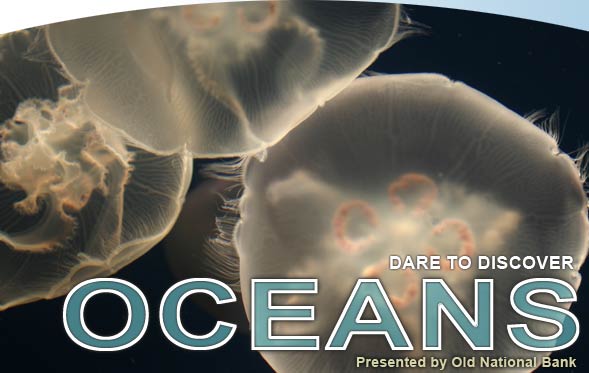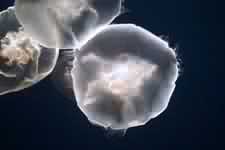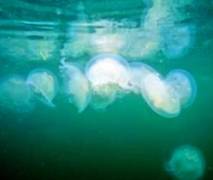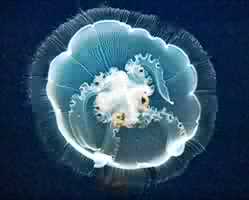 |
| MOON JELLYFISH |

|
| AT THE INDIANAPOLIS ZOO!!!! |
Welcome Everyone to the Oceans Jellyfish Exhibit at The Indianapolis Zoo in Indianapolis, Indiana and I
will be sharing with all of you some fascination Photos and Information about Jellyfish! I hope that you enjoy my Web
Site and please come back often and bring all your Family and Friends with you so they too can enjoy the Photos!
GOD BLESS ALL OF YOU AND YOUR FAMILIES!!!
| MOON JELLYFISH |

|
| AT THE INDIANAPOLIS ZOO!!! |
JELLYFISH-MYSTERIOUS CREATURES OF THE DEEP
Next to the Moray Eels at the Oceans presented by Old National Bank Exhibit are the Moon Jellies. These
beautiful, but Alien Creatures, do not look and act like any other Fish in the Sea, and technically, they aren't really a
Fish at all.
Their Tank is set against the Darkness of the Ocean's Depths so Visitors can marvel at the simplicity and
grace of these Animals as they seemingly float without intention through their Underwater Environment. Here's more information
about the fascinating World of "Jellies."
Jellyfish are Marine Invertebrates belonging to the Scyphozoan Class and in turn the Phylum Cnidaris. The
Body of an Adult Jellyfish is composed of a Bell-Shaped Jelly Producing Substance enclosing its Internal Structure, from which
the Creature's Tentacles are suspended.
Each Tentacle is covered with Stinging Cells (Cnidocytes) that can Sting or Kill other Animals: most Jellyfish
use them to secure Prey or as a Defense Mechanishm. Others, such as Rhizostomae, do not have Tentacles at all. To compensate
for its lack of Basic Sensory Organs and a Brain, the Jellyfish exploits its Nervous System and Rhopalia to perceive Stimuli,
such as Light or Odor, and Orchestrate Expedient Responses.
| MOON JELLIES |

|
| AT THE INDIANAPOLIS ZOO!!! |
In its Adult Form, it is composed of 94-98% Water and can be found in every
Ocean in the World. Most Jellyfish are passive drifters that Feed on small Fish and Zooplankton that become caught in their
Tentacles.
Jellyfish have an Incomplete Digestive System, meaning that the same Orifice is used for both Food Intake
and Waste Expulsion. They are made up of a layer of Epidermis, Gastrodermis, and a thick layer called Mesoglea that actually
produces a main part of Jelly and it separates the Epidermis from the Gastrodermis.
Their Shape is not Hydrodynamic, which makes them slow swimmers but this is little hindrance as they feed
on Plankton, needing only to drift slowly through the Water. It is more important for them that their movements create a Current
where the Water (which contains their Food) is being forced within reach of their Tentacles. They accomplish this by rhythmically
opening and closing their Bell-like Body.
Since Jellyfish do not biologically qualify as actual "Fish," the term "Jellyfish" is considered a misnomer
by some, who instead employ the Names "Jellies" or "Sea Jellies." The Name "Jellyfish" is also often used to denote either
Hydrozoa or the Box Jellyfish, Cubozoa. The Class Name Scyphozoa comes from the Greek Word Skyphos, denoting a kind of Drinking
Cup and alluding to the Cup Shape of the Animal.
Life Cycle and Reproduction
Most Jellyfish pass two different Body Forms during their Life Cycle. The First is the Polyp Stage; in this
Phase, the Jellyfish takes the Form of either a Sessile Stalk which catches passing Food, or a similar Free-Floating Configuration.
The Polyp's Mouth and Tentacles are located anteriorly, facing upwards.
In the Second Stage, the Jellyfish is known as a Medusa. Medusa have a radically symmetric, Umbrella-shaped
Body called a Bell. The Medusa's Tentacles hang from the Border of the Bell. Jellyfish are Dioecious (that is they are either
Male or Female). In most cases, to Reproduce, a Male releases his Sperm into the surrounding Water.
The Sperm then swims into the Mouth of the Female Jelly, allowing the Fertilization of the Ova Process to
begin. Moon Jellies, however, use a different Process: their Eggs become lodged in Pits on the Oral Arms, which form a temporary
Brood Chamber to accomodate Fertilization.
After Fertilization and Initial Growth, a Larval Form, called the Planula, develops from the Egg. The Planula
Larva is small and covered with Cilia. It settles into a firm surface and develops into a Polyp.
The Polyp is Cup-shaped with Tentacles surrounding a single Orifice, perhaps resembling a Tiny Sea Anemone.
Once the Polyp begins Reproducing Asexually by Budding, it's called a Segmenting Polyp, or a Scyphistomae. New Scyphistomae
may be produced by Budding or New Immature Jellies called Ephyra may be formed. Many Jellyfish can Bud off New Medusa
directly from the Medusan Stage. Most Jellyfish do not live longer than Six Months, 2 and a Half Months being more Common.
| MOON JELLY |

|
| AT THE INDIANAPOLIS ZOO!!! |
Defense and Feeding Mechanisms
Most Jellyfish have Tentacles or Oral Arms coated with Thousands of Microscopic Nematocysts; generally,
each of these Nematocyst has a "Trigger" (Cnidocil) Paired with a Capsule containing a Coiled Stinging Silament, as well as
Barbs on the Exterior. Upon contact, the Filament will swiftly unwind, launch into the largest and inject Toxins. It can then
pull the Victim into its Mouth, if appropritate.
Although most Jellyfish are not perniciously dangerous to Humans, a few are Highly Toxic, such as Cyanea
Capillata. The recently discovered Carukia Barnesi is also suspected of causing two Deaths in Australia. Contrary to popular
belief, the menacingly Portuguese Man o'War (Physalia) is not actually a Jellyfish, but a Colony of Hydrozoan Polyps. Regardless
of the actual Toxicity of the Stings, many Victims find them very painful, and some Individuals may have Severe Allergies
similar to Bee Stings.
A Jellyfish can detect the touch of other Animals using a Nervous System called a "Nerve Net," which is
found in its Epidermis.
Impulses to the Nerve Cells are sent from Nerve Rings that have collected information from the Environment
of the Jellyfish through the Rhopalial Lappel, which is located around the Animal's Body.
Jellyfish also have Ocelli that cannot form Images, but are sensitive to Light; the Jellyfish can use these
to determine up from down, basing its judgement on Sunlight shining on the Surface of the Water.
Jellyfish do not have a Specialized Digestive System, Osmoregulatory System, Central Nervous System, Respiratory
System, or Circulatory System. They are able to digest with the help of the Gastrodermis that lines the Gastrovascular Cavity,
where Nutrients from their Food are absorbed.
They do not need a Respiratory System since their Skin is thin enough that Oxygen can easily diffuse in
and out of their Bodies.
Jellyfish have limited control over their Movement and mostly Free-Float, but can use a Hydrostatic Skeleton
that controls the Water Pouch in their Body to Actuate Vertical Movement.
In Cell Biology, Ectoplasm ("Outer Plasma") refers to the Outer Regions of Jellyfish. The Jelly like Material
called (Eczoplasma or Pllassy for short) typically contains a smaller amount of Protein Granules and other Organic Compounds
than Inner Cytoplasm, also referred to as Endoplasm.
Blooms and Grouping
A Group of Jellyfish is often called a "Smack." Many Species of Jellyfish are also capable of congregating
into Large Swarms or "Blooms" consisting of Hundreds or even Thousands of Individuals.
The Formation of these Blooms is a Complex Process that depends on Ocean Currents, Nutrients, Temperature
and Oxygen Content. Jellyfish will sometimes Mass Breed during Blooms.
Jellyfish population is reportedly raising Major Ecological Concerns for a possible Jellyfish Outbreak.
According to Claudia Mills of the University of Washington, the frequency of these Blooms may be attributed
to Mankind's impact on Marine Life. She says that the Breeding Jellyfish may merely be taking the place of already Overfished
Creatures. Jellyfish Researcher Marsh Youngbluth further clarifies that "Jellyfish" Feed on the same kinds of Prey as Adult
and Young Fishes, so if Fish are removed from the Equation, Jellyfish are likely to move in."
Increased Nutrients in the Water ascribed to Agricultural Runoff, have also been cited as an Antecedent
to the recent proliferation of Jellyfish numbers. Scientist Monty Graham says that "Ecosystems in which there are high levels
of Nutrients...provide Nourishment for the small Organisms on which Jellyfish Feed. In Waters where there is Eutrophication,
Low Oxygen Levels often result, favoring Jellyfish as they thrive in less Oxygen-rich Water than Fish can tolerate. The fact
is that Jellyfish are increasing is a Symptom of something happening in the Ecosystem."
By sampling Sea Life in a heavily Fished Region off the Coast of Namibia, Researchers have found that Jellyfish
have actually overtaken Fish in terms of the Biomass they contribute to this Ocean Region. The Findings represent a careful
quantitative Analysis of what has been called a "Jellyfish Explosion" following intense Fishing in the area in the last few
decades. The Findings were reported by Andrew Brierley of the University of St. Andrews and his Colleagues in the July 12,
2006 Issue of the Journal Current Biology.
Areas seriously affected by Jellyfish Blooms include the Northern Gulf of Mexico, where "Moon Jellies have
formed a kind of Gelatinous Net that stretches from end to end across the Gulf," and the Adriatric Sea (some Jellyfish have
even been spotted along Coastal Shores.
|

